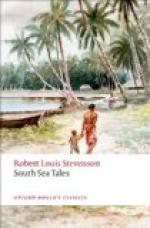The hamlet of Anaho stands on a margin of flat land between the west of the beach and the spring of the impending mountains. A grove of palms, perpetually ruffling its green fans, carpets it (as for a triumph) with fallen branches, and shades it like an arbour. A road runs from end to end of the covert among beds of flowers, the milliner’s shop of the community; and here and there, in the grateful twilight, in an air filled with a diversity of scents, and still within hearing of the surf upon the reef, the native houses stand in scattered neighbourhood. The same word, as we have seen, represents in many tongues of Polynesia, with scarce a shade of difference, the abode of man. But although the word be the same, the structure itself continually varies; and the Marquesan, among the most backward and barbarous of islanders, is yet the most commodiously lodged. The grass huts of Hawaii, the birdcage houses of Tahiti, or the open shed, with the crazy Venetian blinds, of the polite Samoan—none of these can be compared with the Marquesan paepae-hae, or dwelling platform. The paepae is an oblong terrace built without cement or black volcanic stone, from twenty to fifty feet in length, raised from four to eight feet from the earth, and accessible by a broad stair. Along the back of this, and coming to about half its width, runs the open front of the house, like a covered gallery: the interior sometimes neat and almost elegant in its bareness, the sleeping space divided off by an endlong coaming, some bright raiment perhaps hanging from a nail, and a lamp and one of White’s sewing-machines the only marks of civilization. On the outside, at one end of the terrace, burns the cooking-fire under a shed; at the other there is perhaps a pen for pigs; the remainder is the evening lounge and al fresco banquet-hall of the inhabitants. To some houses water is brought down the mountains in bamboo pipes, perforated for the sake of sweetness. With the Highland comparison in my mind, I was struck to remember the sluttish mounds of turf and stone in which I have sat and been entertained in the Hebrides and the North Islands. Two things, I suppose, explain the contrast. In Scotland wood is rare, and with materials so rude as turf and stone the very hope of neatness is excluded. And in Scotland it is cold. Shelter and a hearth are needs so pressing that a man looks not beyond; he is out all day after a bare bellyful, and at night when he saith, ’Aha, it is warm!’ he has not appetite for more. Or if for something else, then something higher; a fine school of poetry and song arose in these rough shelters, and an air like ‘Lochaber no more’ is an evidence of refinement more convincing, as well as more imperishable, than a palace.




